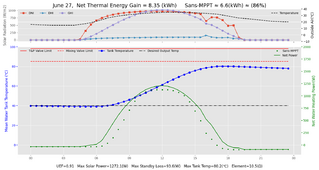A few years ago I hooked some some panels to the bottom element of my water heater. It has worked so well, I wanted to make it easier for more people to try it. So made a simulator app that helps with the design of PV hot water systems. The simulator is basically PVWattsV8 with some water heater stuff bolted on.
You put in your info at the top and on the bottom you can view expected monthly production and graph the daily temperature swing of your water heater.
Any feedback about problems you have with this tool, or things I could improve would be much appreciated.
You put in your info at the top and on the bottom you can view expected monthly production and graph the daily temperature swing of your water heater.
Any feedback about problems you have with this tool, or things I could improve would be much appreciated.





